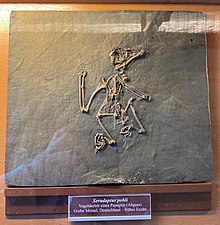Halcyornithidae
| Halcyornithidae Temporal range:
| |
|---|---|

| |
| Cast of the holotype of Serudaptus, a halcyornithid, at the Natural History Museum of Vienna | |
| Scientific classification | |
| Domain: | Eukaryota |
| Kingdom: | Animalia |
| Phylum: | Chordata |
| Class: | Aves |
| Clade: | Eufalconimorphae |
| Family: | †Halcyornithidae Harrison & Walker, 1972 |
| Genera | |
| |
| Synonyms | |
|
Pseudasturidae (Mayr, 2002) | |
Halcyornithidae is an extinct family of
Description
Halcyornithids are recognisable by details of the skull and limbs. The tarsometatarsus, the lowermost bone of the leg, is short and shaped like those of parrots. The distal end of the tarsometatarsus has a projection of bone that supports the fourth toe, which is reversed and faces backwards.[3] Unlike in parrots, however, this projection is not separated by a groove from the rest of the trochlea supporting the other toes. The third toe is strongly built, more so than the others. The humerus is long and slender, and the coracoid is shaped like that found in owls, and has a foramen for the supracoracoideus nerve.[2]
The skulls of halcyornithids bear a prominent shelf of bone above the upper margin of the eye, the supraorbital process, comparable to that present in falcons and other birds of prey. One proposed function of the supraorbital process is mechanical protection of the eyeball from injury, for example, such as might be caused by struggling prey animals being killed with the beak.[1] The morphology of the head is overall similar to that of messelasturids, but in halcyornithids, the mandible is proportionally much longer.[4]
Distribution
A high diversity of halcyornithid birds is found in the Eocene
Classification
Placement of the Halcyornithidae after Ksepka et. al, 2019.[6]
| |||||||||||||||||||||||||||||||||||||
Internal classification of the Halcyornithidae and Messelasturidae after Mayr & Kitchener, 2022.[7]
References
- ^ S2CID 259969084.
- ^ ISBN 978-3-030-87644-9.
- ^ Dyke, Gareth (2001). "Fossil pseudasturid birds (Aves, Pseudasturidae) from London Clay". Bulletin of the Natural History Museum, Geology Series. 57: 1–4 – via Biodiversity Heritage Library.
- ISSN 2193-0066.
- S2CID 62901085.
- PMID 30744971.
- ISSN 0891-2963.
